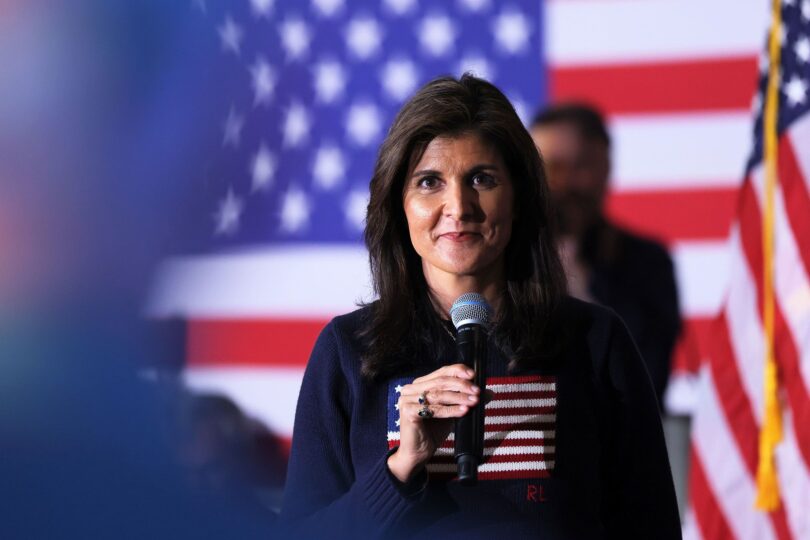Nicole Hemmer
Picking through the rubble of the 2016 election, journalists not only peered deep into the rural red counties of Trump country and the ragged remains of the Clinton campaign, but also turned inward, toward themselves. There had been so much newsprint acreage devoted to Hillary Clinton’s emails and so many hours devoted to wall-to-wall coverage of Donald Trump’s rallies; a wave of recriminations from readers and colleagues alike rained down on the press, which, the argument went, had badly fumbled its campaign coverage and contributed to Donald Trump’s victory. It was time for a reckoning.
And yet for all the soul-searching, as we approach 2024, it’s clear that not much has changed – for Trump or for the journalists who cover him. As the GOP primary debates unfold and the race heats up, we have gotten a sense of how little has been learned from 2016.
Coverage of the candidate’s recent use of the word “vermin” and his unhinged Truth Social posts keep Trump center stage, reinforcing polls that show Trump’s overwhelming lead against his primary competitors. Talk of policies and the stakes of another Trump presidency – which has attracted increasing attention – still take a backseat to the same horserace approach we had supposedly reckoned with so thoroughly. The stories generate a lot of heat, but not much light. And if this style of reporting dominates as the 2024 campaign moves into the general election, Americans will be unprepared for the election ahead.
That’s because we have a political press that has learned to talk a lot about the endangered state of US democracy without providing voters with the stories and information they need to make sense of the 2024 elections. Voters don’t just vote with the future of their form of government in mind: they vote on what they perceive to be the personality, policies, and politics of the candidates. Coverage of the Republican primaries -and of Trump’s most viable primary competitor- reveals just how much the current approach obscures the bigger stakes and developments while often delivering little more than inside baseball and tenuous predictions about the campaigns.
The experience of South Carolina Gov. Nikki Haley is instructive. In the primary debates, which Trump has skipped, she has emerged as a candidate with a set of policy prescriptions and approaches that at times sharply diverge from Trump and the other candidates on stage. More hawkish in foreign policy, more skeptical of anti-abortion absolutism, less interested in notions of economic populism, Haley might stand in for the George W. Bush/Paul Ryan wing of the party, presumed to be a nearly-extinct part of the Republican coalition since the rise of Trump. That view is reinforced by news that broke Tuesday: Haley has received the endorsement of Americans for Prosperity Action, a SuperPAC founded by David and Charles Koch. The New York Times, in reporting the endorsement, went all in on the campaign strategies and electoral positioning, discussing Haley’s position in the polls, the SuperPAC’s deep pockets and the desire to “turn the page” on the Trump era. But nowhere does it talk in depth about policy or what the Koch brothers’ organization represents within the Republican coalition. The Times did mention foreign policy, noting Haley’s criticism of the US withdrawal from Afghanistan, advocacy for military strikes in Iran and her hawkish support for Ukraine aid.
But there’s so much more to say. The Koch brothers have long represented the corporate wing of the party, pushing for policies that benefit big business and the wealthy: low taxes, low wages, open immigration, free trade, and the like. And those interests shape their support of Haley. It’s information that campaign reporters did not have to look far to find. The endorsement discusses Haley’s education and health care policies, and hints at her anti-union, pro-industry stances. What makes Haley interesting in this race is not, in fact, her position in the polls but her position in the party. She not only represents a once-dominant faction of the GOP, but also shows us how that wing of the party has accommodated to the Trump era. Haley was, after all, Trump’s ambassador to the United Nations, an interesting position for someone who so sharply diverges from Trump’s ostensibly non-interventionist foreign policy. She has adopted a harder line on immigration – something the Koch brothers would once have frowned upon – and has leaned hard into anti-trans rhetoric and policies. She has framed the Trump indictments as political prosecutions and sources of unnecessary drama, the latter an indication of her wariness about attacking Trump too hard. That clarifies something about Haley, who otherwise has been a kind of silly-putty figure in the race, someone upon whom Trump-wary Republicans and independents can impress their own preferences. Haley emerges as a moderate, defined by her decision to remove the Confederate flag from the state capitol after the racist massacre in Charleston in 2015, or as a budget-balancing wonk, defined by her willingness to entertain Social Security and Medicare cuts. Or maybe it’s Haley, the standard-bearer for a more inclusive Republican Party, defined by her identities as a woman and Indian-American. But none of those fully captures the real Haley’s politics or policy preferences.
Contextualizing both the endorsement and Haley’s policy positions can help us see how Republicans who disagree with Trump have accommodated him without jettisoning many of their broader political commitments.
It not only tells us something about the composition of the party and its voters, but it clarifies some of the developments of the Trump era: the supposed economic populist president who instituted deep tax cuts for the wealthy, attempted (and is still attempting) to repeal the Affordable Care Act, and who met with non-union autoworkers in Detroit during the recent United Auto Workers strike. With that clarity in mind, journalists could make clear the stakes of a second Trump presidency that goes beyond the very real threats to democratic governance that it poses. There are real material consequences to a Trump presidency that would leave working-class Americans in worse shape economically. There may be a strain of Republicans interested in thinking about economic populism, but when it comes to actual governing, the Haley wing remains in the driver’s seat.
All of this requires a fundamentally different approach to election coverage. Campaign reporting has changed on the margins. Journalists sometimes push back against Trump. They use the word “lie” and even the word “fascism.” But when it comes to election coverage itself, the main model is still the same, fueled by polls and predictions and palace intrigue, and decidedly less interested in policy and longer-term transformations to the parties and their voters. That’s the finding of a new report from the Columbia Journalism Review, which studied the front pages of the New York Times and Washington Post in the run-up to the 2022 midterms, to see how much had changed since 2016. Their answer? Not much.
“We found that the Times and the Post shared significant overlap in their domestic politics coverage, offering little insight into policy,” the report’s authors wrote. “Both emphasized the horse race and campaign palace intrigue, stories that functioned more to entertain readers than to educate them on essential differences between political parties.” The Post showed a bit more interest in issues of interest to Democrats, while the Times focused on Republican issues, but the papers shared the same timeworn – and frankly, profitable – approach to campaign coverage. It’s a model that has been in effect for decades – and one that has taken heavy criticism since well before Trump.
In 2012, journalist Patrick Hruby decried what he called “The SportsCenter-ization of Political Journalism,” a critique that still holds up today. Media criticism was a backbone of both The Daily Show with Jon Stewart and the Colbert Report, and remains a central mode of analyzing US politics. But that criticism has not led to wholesale institutional reform – in part because change is hard and expensive, in part because it’s risky, in part because the horserace model fits a set of journalistic values around objectivity and balance that is much harder to meet in analytical and contextual coverage. (And, of course, in part because readers often don’t display appetite for policy stories, a hindrance in a media universe where success is largely a function of reader engagement.) But the change has to happen, and soon. A democratic system can’t survive without strong, independent, and useful journalism – for a democratic system on the brink, it is even more vital.
CNN







